
Text © DrSc Giuliano Russini – Biologist Zoologist

English translation by Mario Beltramini
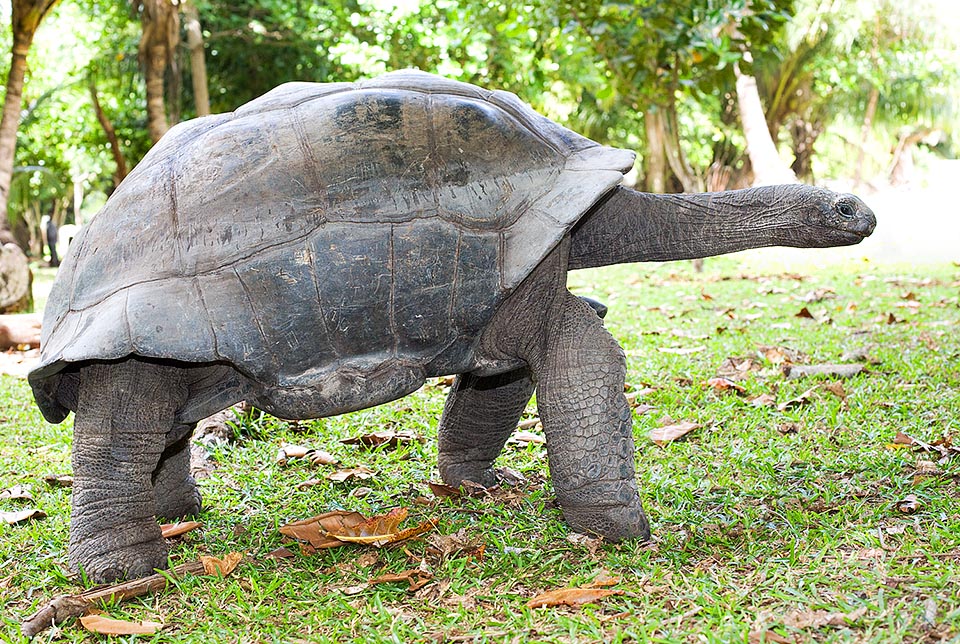
The order of the Testudines is a primitive group. All its members have remained practically unchanged since 200 millions of years ago © Giuseppe Mazza
During the end of the Paleozoic Era (called also Protozoic or Primary, period Permian) and the beginning of the Secondary Era (called also Mesozoic), something substantial and fundamental for the evolution of the animal life, till then evolved only in aquatic habitat, both of sea and of fresh water, is going to allow the final conquest of the mainland. This happened through the birth of the Reptilians (class: Reptilia). The first forms of vertebrates, which were already partially spending some time on the mainland, belonged to the class of the Amphibians (Amphibia), considered by the biologists as the oldest terrestrial vertebrates, or which were able to move also on the mainland, probably evolved from an extinct suborder of fish, the Rhipidistia. But even if they were animals able to breathe the atmospheric oxygen by means of the lungs, the amphibians were and still are strongly bound to the water.
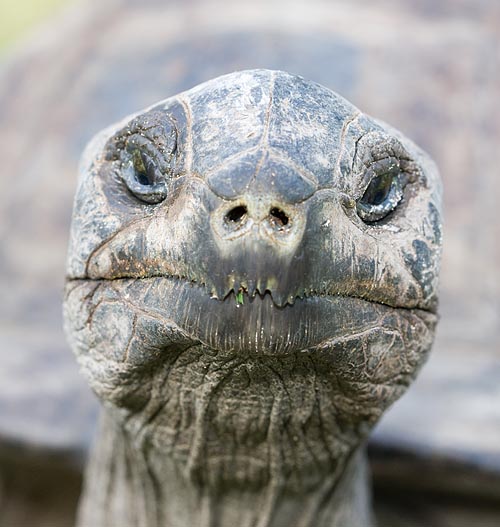
This Dipsochelys elephantina is a jump into the prehistory © Giuseppe Mazza
They require puddles or however aquatic habitats for reproducing, laying the eggs and carry on a part of their vital cycle, like the indirect development (larval), where the animal passes, through metamorphosis, from a wholly aquatic life stage, that of the tadpole who breathes through gills the oxygen dissolved in the water, to the adult form, capable to carry on also a terrestrial life.
Also at the adult stage, apart for reproduction, the amphibians must often go back to the aquatic habitat due to the histological features of their skin which is not able to retain the body water. They quickly dehydrate and therefore cannot get far away from the water too frequently and for long time.
The first vertebrates, totally independent from the aquatic habitat, which carry on their whole vital cycle on the mainland (birth, development, sexual maturation, mating/reproduction, death), have been the Reptilians (class: Reptilia).
These animals, perfectly adapted to the terrestrial life, distinguish easily from the amphibians, due to their scaly skin, which protects them from dehydration and from exsiccation. Unlike amphibians, they do not have an indirect development, characterized by larval stages.
The newborns have already the look of the adults and will take, growing, their dimensions. The respiration is wholly pulmonary, neither branchial, nor cutaneous.
The fecundation is internal (endogenous), Amphigenous (by merging of a spermatozoon and an ovule). But some Russian biologists seem to have observed during the sixties some lizards, present in the Caucasian mountain regions, characterized by a reproduction by Parthenogenesis (virginal reproduction), for which an oocyte activates by balancing its own number of chromosomes, so much that it goes from an haploid value (n) to a diploid one (2n), similarly to what happens by means of the spermatozoon during the Amphimixis (from the old Greek amfi = from both sides and mixis = mix), in this case bay environmental stimuli (physical, chemical or biological) without the intervention of the opposite sex.
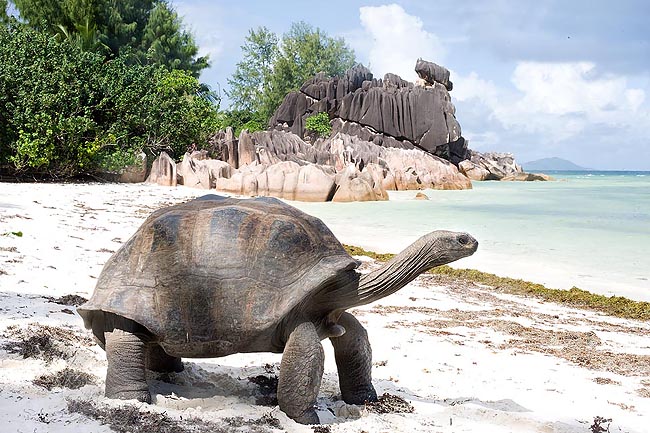
The Dipsochelys elephantina of the Seychelles is the greatest terrestrial tortoise © Giuseppe Mazza
Even if most reptilians lay eggs (oviparous), there are viviparous species where the foetus develops in gestation chambers, uteri or special oviducts present inside the mother. A complete and formed offspring comes to life and its size will increase with time.
Other species may have a reproduction called ovoviviparous, where eggs with the shell get form; they are not laid on the ground but remain inside the oviducts, where they open at a certain stage of the embryo development.
The fragments of the shell are re-absorbed by the mother, and the young are nourished and oxygenated by means of a digitiform Omphalo-placenta, called also Allanto-placenta.
In this way, they continue their development inside the body of the mother and come to life in a form similar to that of the viviparous reptilians, that is, already morpho-functionally complete. Typical examples of reptilians endowed with this particular reproductive modality are the Green Anaconda (Eunectes murinus), endemic to South America and the Mabuya mabouya, a lacertilian saurian endemic to the tropical Jamaican forest. As it happens for the mammals inside the uterus, for the reptilians and the birds the embryo is contained in a sac full of liquid inside the egg, called Amniotic sac. This allows the embryo to drink and develop on the mainland, without dehydrating, in a close system, the egg, protected by a shell formed by salts of calcium carbonate with a porous structure.
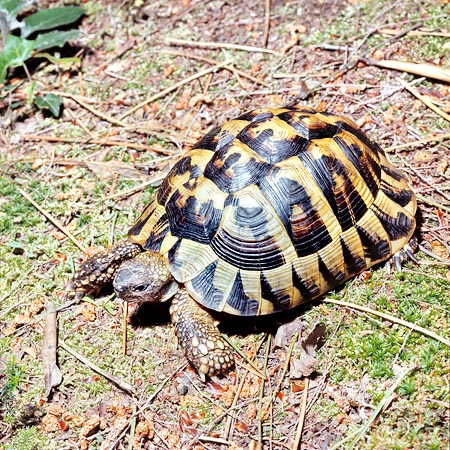
The testudo hermanni has a winter lethargy © Giuseppe Mazza
This type of egg, common to reptilians and birds, defined by the biologists as “Cleidoic”, is one of the keystones which have rendered some reptilians the first vertebrates completely independent for the purely aquatic biotopes.
All the vertebrates having an amniotic sac enveloping the embryo under development, are called amniotic or amniotes and are represented by the members belonging to the classes of the reptilians, birds and mammals.
The others, which do not have this membrane, are called anamniotes and do belong to the class of fish and of the amphibians. A sac-shaped protuberance of the digestive tract of the embryo, the allantois, absorbs oxygen from the external environment and collects the wastes (CO2, urine), for removing them from the area where it is developing.
Contrary to the mammals and the birds, which are endothermic or entothermic, popularly called warm-blooded animals, the reptilians, as well as the amphibians and fish, are cold-blooded animals: they cannot govern the temperature of their body with inner means, for instance through the oxidative metabolism of the nutritive substances they have taken, but they keep it constant, by changing position, that is, moving from the sun to the shade, or vice versa, at each time.
For this reason, they are called poikilothermic or ectothermic.
With regard to this, it is necessary to keep in mind that several species of reptilians, as well as some species of mammals (bears, hazel dormice, fat dormice, etc.), are subjected to phenomena of quiescence, called by the biologists hibernation or lethargy if in winter and aestivation when in summer. In both cases, the temperature, too low or too high, is one of the mechanisms causing such physiological phenomena, without ignoring other eco-physiologic and etho-physiologic reasons to which the Autoecology (environmental physiology) of the single animal.
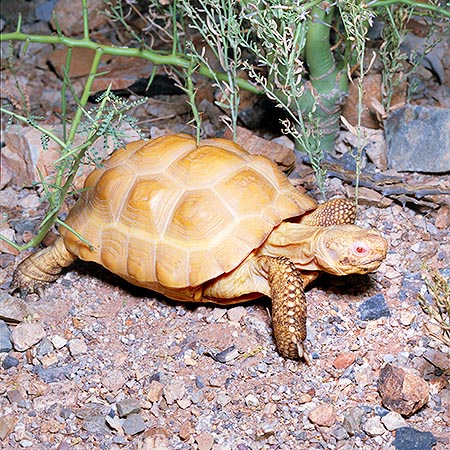
An albino Gopherus agassizii in the Arizona desert © Giuseppe Mazza
If the winter temperature gets too low, or the summer one too high (with, at the same time, scarcity of food), in order to be tolerated without any damage by a reptilian, being associated also with variations of the photoperiodic stimulus, caused by the reduction or extension of the day/night period, phenomenon which depends from the zoogeographic distribution of the species and from the evolution of the astronomic arc covered by the earth, which determinates the succession of the seasons, all above will result in a stimulus for the animal involved to hibernate or aestivate.
We have to add to these ecologic phenomena other physiologic ones which, even if induced by the ecologic variations, are indispensable inducers of the lethargy and the aestivation.
For instance, an increase of the concentration of CO2 inside the den of the animal and an increment of the hematic title of melatonin (a hormone secreted by the pineal gland), sensitive to the variations of temperature and of local photoperiod, concur in inducing the two aforementioned phenomena.
Both during the lethargy and during the aestivation, the temperature curve of the reptilian will vary in such a way that the body temperature will always be of 1°-2° over or under the environmental one, therefore the biological fluids will never perceive a temperature of freezing or of thermal stress.
The metabolic rate goes drops to baseline, the proof is the lowering of the body temperature, and the liver glycogen reserves are activated along with those of fat storage, for nourishing the animal till when it will be again active.
And, lastly, there is a remarkable lowering of the expression, the secretion and the activity of many digestive enzymes, such as proteases, lipases, glucosides, etc.
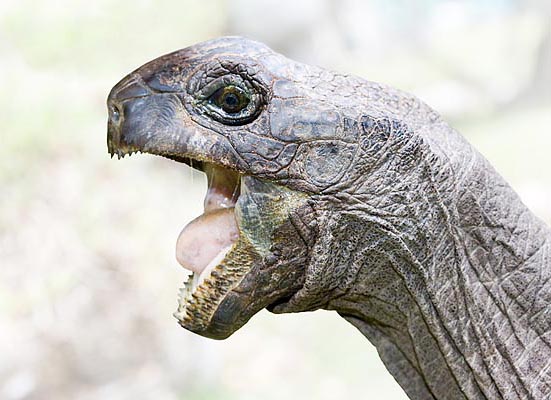
Tortoises don’t have real teeth with roots, but at times, robust small denticles © Giuseppe Mazza
As a consequence, when, for instance, once gotten the necessary permissions, we breed for hobby in our garden the common Hermann’s Tortoise (Testudo hermanni or Testudo hermanni hermanni), we have always to provide the animal of a suitable shelter for its lethargy, which, in Europe, takes place by February.
A few days before starting the lethargy, the animal, spontaneously, will eat progressively less, till the complete fast.
Often amateurish breeders make the mistake of forcing the animal to eat, as they think that it may suffer from some pathology which causes its lack of appetite.
Nothing can be more wrong, because if the animal eats before starting its lethargy, the reduced digestion activity which follows, does not allow the food assumed to be digested.
This will decay, causing septicemic infections in the animal, intestinal congestion and consequent intestinal paralysis, thus carrying it to death during the sleep.
The food taken spontaneously by the reptilian before starting its lethargy, is sufficient for its metabolic needs.
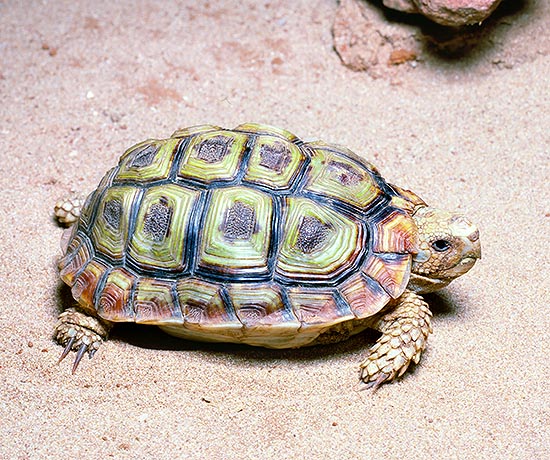
The Homopus areolatus, endemic to South Africa, has a big parrot-like beak © Giuseppe Mazza
All reptilians, but some minor variation, have one heart and a double, but not complete, circulation.
The heart (myocardium) is characterized by two atria and one ventricle.
For this reason, part of the venous blood coming from the corporeal circulation (systemic), mixes inside the heart with the oxygenated one coming from the lungs.
The mandible is formed by several bones, instead of one only as it happens in the mammals, and is articulated to the skull with a bone, called “square”.
Usually, reptilians do have a “polyphydont” and “homodont” dentition, that is, have teeth which are replaced continuously and are all the same.
The lost teeth, are replaced by others and are usually of conical shape, all alike, but in the poisonous ophidians (snakes), where the venomous teeth have special morphologic functional characteristics which differentiate them from the others present in the palate.
For instance, the man is diphyodont, as after his birth has a first dentition of 20 teeth, called milk or deciduous, completely replaced, later on, during the development and the maturity, by a final second set, formed by 32 teeth, and is heterodont, as he has teeth of various type and function, like the canines, the incisors, the premolars and molars, symptomatic of an omnivorous diet. There are no teeth in the turtles and tortoises.
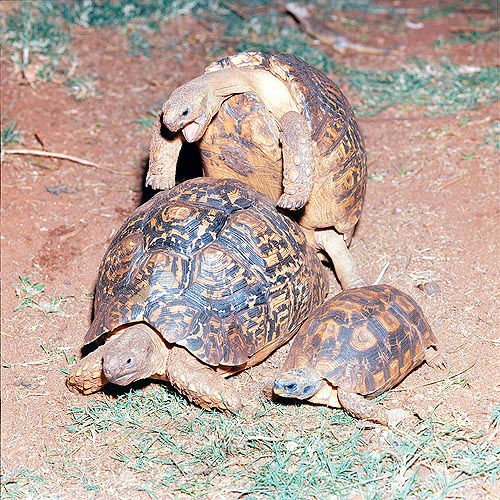
Giochelone pardalis. For many, tortoises are symbol of sexual power © Giuseppe Mazza
In the rare species where they are observed, they are not true and proper teeth, provided with a root. For instance, in the snapping turtle, it is mainly matter of very robust conical small teeth.
By sure, the sea turtles do not have teeth, but have very robust cartilaginous mouth cases, called “rhamphotecas” with which, for instance, they eat jellyfish, squids, crustaceans, fish, etc.
We have to pinpoint that whatever reptilian, a turtle, a snake, a lizard or an alligator, does not chew, but snatches the food and swallows it, like the carnivorous mammals (but the human being).
On the point of view of the comparative anatomy, in biology, the reptilians are subdivided into four basic classes: the Anapsida (the most ancient living, to which belong the turtles, the tortoises and the cotylosaurs), the Diapsida, the Parapsida and the Sinapsida.
Anapsida : means “without arch”. The post-orbital bone and the squamous one are united in such a way to form a smooth surface, without fossae nor fissures or fenestrae, are typical of the turtles and tortoises.
Diapsida : to this class belong the Loricates (crocodiles, alligators, gharials, caymans) and the Saurians (lizards), which have the skull with two foramina in its lateral-rear side.
Parapsida : they have only one temporal fenestra, corresponding to the upper temporal fenestra of the diapsids. This dermal covering was typical of the Ichthyosaurs and the Plesiosaurs, nowadays extinct.
Sinapsida : they have only one temporal fenestra, homologous to the lower temporal fenestra of the diapsids. It characterizes the reptilians belonging to the mammalian lineage: Pelycosauria and Therapsida.
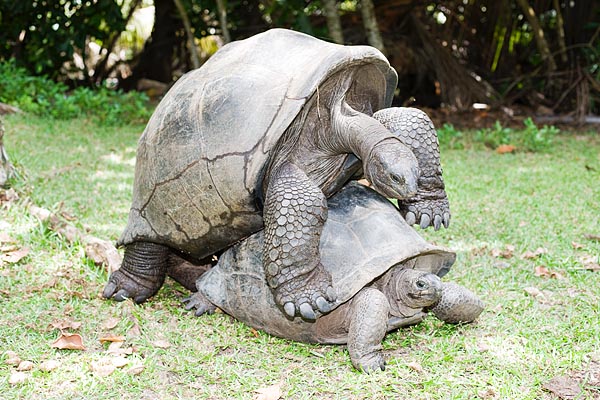
Dipsochelys elephantina. The concave plastron of the male immobilizes the refractory females © Mazza
In some therapsid reptilians and in the mammals, the parietal bones go down to cover the temporal fenestra, at which place remains a temporal depression, called temporal fossa. In these animals the chewing muscles have a completely external insertion.
Taxonomically, the class of the Reptilia is subdivided in four orders:
►Testudines : tortoises, that is terrestrial and fresh-water turtles, and the real and proper turtles, which are those living in the sea.
Rhynchocephalia: characterized by one only living species, the Sphenodon punctatus, forming the family Sphenodontidae. It was common all over New Zealand, but nowadays it can be found only on the small islands along the northern coast of the island.
►Squamata : the group of the presently more evolved reptilians. Do belong to this group the saurians (lizards) and the ophidians or snakes.
►Crocodilia : that is the crocodiles, the alligators, the caymans and the gharials. Between the extant reptilians, the crocodile would seem to remind closer the extinct dinosaurs.
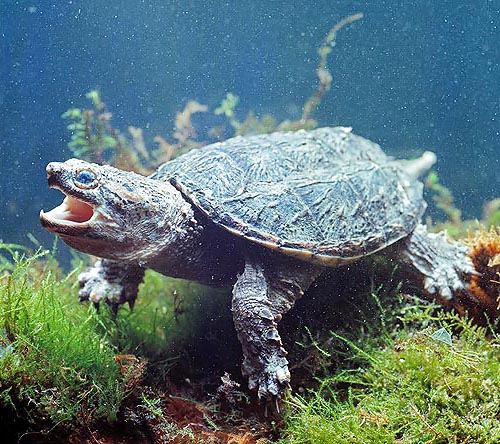
The Chelydra serpentina of North America is much aggressive © Giuseppe Mazza
In this opus we shall linger more in detail upon the members of the order of the Testudines.
In consequent specific texts, we shall treat about the other orders of the reptilians in a more precise manner.
The order of the Testudines is a primitive group.
All its members (chelonomorphs)have remained practically unchanged since 200 millions of years ago (Mesozoic Era) up to our times.
They have a shell composed by bony plates covered by horny scales. It forms an upper curved cuirass, the carapace, and a flat lower one, the plastron.
The ribs, motionless and merged with the carapace, do not collaborate in the respiration which takes place with the help of the abdominal muscles.
In this case, these muscles perform a function which is equivalent, in the respiration, to that done by the diaphragm in the mammals.
Furthermore, in the species living at sea, in addition to the atmospheric CO2, inspired through the lungs when the animal surfaces or is on the beach for deposing its eggs, a part of the respiration during the immersion (even if in percentage this contribution is not so important) comes from the water which, through the cloaca, reaches the urodeum, which is abundantly vascularised.
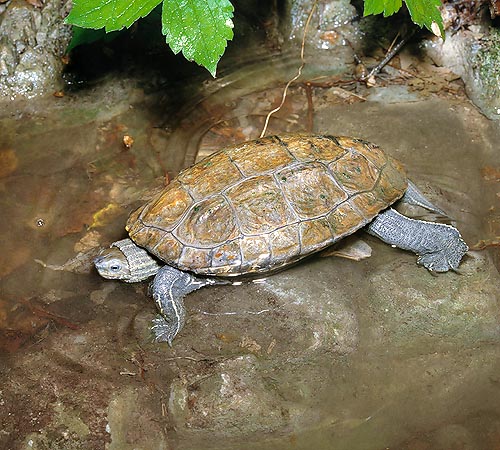
The Mauremys caspica is omnivorous, common in the Balkans and in Near East © Mazza
This, along with a less intense metabolism, which characterizes all species, terrestrial and aquatic, allows the sea turtles to effect long lasting apnoeas at great depths.
Without forgetting that, like for the amphibians, also for the chelonomorphs, the pharynx covers a very important function of pumping the air into the lungs.
The urogenital apparatus, both in the terrestrial and the aquatic species, consists in a couple of kidneys at the stage of metanephros, called uricotelic kidneys, ammonotelic kidneys or ureotelic kidneys, which forms and expels, in the terrestrial species, urine under the form of uric acid, like it happens for the birds, and under form of ammonia or urea in the aquatic ones.
Also, in the marine species, there are glands for the expulsion of the salt, placed in the orbital-ocular region.
These glands allow, when the animal (which is an osmoregulator, like all vertebrates) is in a terrestrial location, on a beach, for instance, during the mating or during the deposition of the eggs, to expel the exceeding salt which has been accumulated when at sea.
For this reason, romantically, they said in the past that the females of sea turtles were crying while laying their eggs.
As a matter of fact, the liquid coming out is a hypertonic solution, necessary for eliminating the excess of salt.
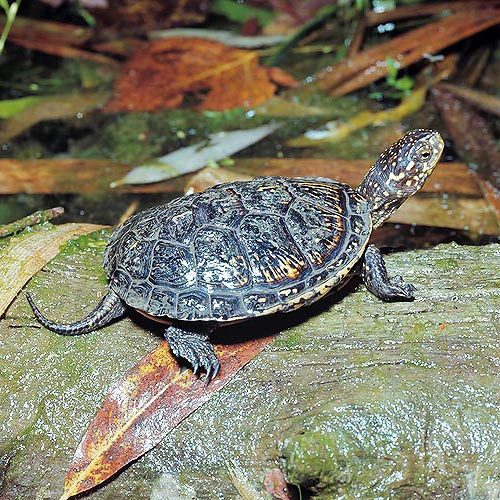
The Emys orbicularis is present in almost the entire European continent © G. Mazza
Usually, both in turtles and tortoises, there is one penis only (in the snakes this is doubled, one at the time is utilized in the copulation), which is maintained erect during the intercourse by a congestion induced by the lymphatic fluid, present in the lymphatic vessels and folds and by the blood which fills it through the blood vessels.
It has as structure with a central channel through which the sperm passes, for being laid through the cloaca into the feminine urodeum.
The coupling phase is characterized by nuptial rituals, which vary depending on the species.
Briefly, referring to the final stages of these ones and treating about such rituals in the special writings, the male will latch on the female with its fore limbs, biting it and penetrating its cloaca several times with the penis.
In some species of reptilians, like the boids, the sperm may be conserved in the oviduct of a female even for 25 years and by that time it can still be able to fecundate the ovule.
In the Testudines it maintains for several months.
Even if they have a similar egg, we must remind that the reptilians, contrary to the birds, do not have the brooding process in their reproductive cycle. The parental cares are reduced to the least.
Usually, whether chelonomorphs, saurians, snakes or loricates, the mother lays the eggs in a den dug into the soil, sand, clay, peat or places them in a pseudo nest. This is built in very primitive way if compared with the birds.
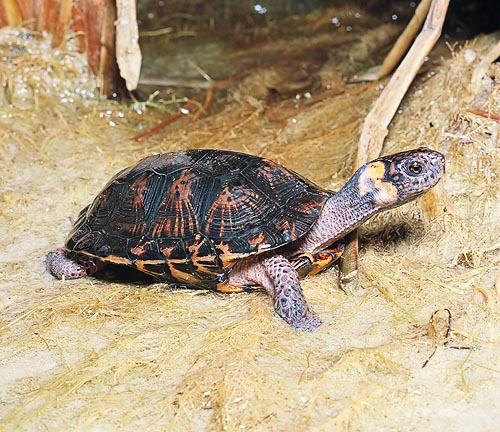
The Clemmys muhlenbergii of Florida is one of the smallest species © Giuseppe Mazza
In order to hide them to the predators, the eggs are for instance hidden in the hollow of a trunk tree, or in a hole, insulating it with leaves, earth, sand and peat, thus to keep constant the incubation temperature. After this, the mother abandons them.
Till now, the biologists have observed the female brooding its own eggs in only one species of reptilians, even if in an original way. This is the Indian Rock Python (Python molurus bivittatus), family of the Boidae. In this species, the female lays about fifty eggs, which then surrounds by winding them. Then, by increasing the frequency of the contraction of the folds of the body, it increases its body temperature, giving the eggs the right temperature of brooding and incubation.
Lastly, in the chelonomorphs, such as in the Sphenodon, there is a sensory organ, which reaches its maximum degree of development in the snakes and the saurians, placed, with the forms of two dimples, in the vault of the palate, called “Vomeronasal Jacobson’s Organ”, after the name of the biologist who described it by the first half of 1800.
This sensory organ, present, even if lesser developed, also in the mammals, allows the reptilians to perceive smells and tastes of organic particles present in the atmosphere, as well as in the water or in the soil, in infinitesimal concentrations, of the orders of parts per millions (p.p.m.).
The order of the Testudines, subdivides in two suborders: the Cryptodires (Cryptodira), the turtles which retract their head into the shell by bending their neck, and the Pleurodiras (Pleurodira), which retract their head into the carapace, by folding their neck laterally.
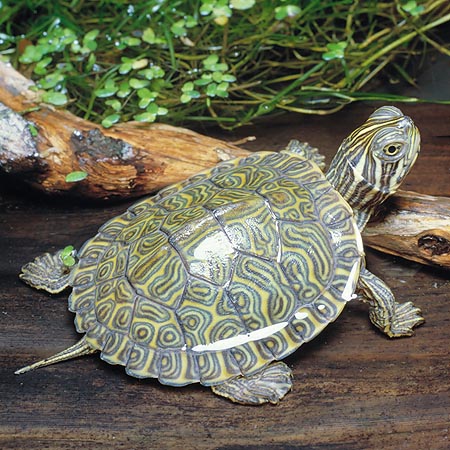
Spectacular patterns of a Pseudemys concinna hieroglyphica © G. Mazza
►Suborder Cryptodira. Count 10 families:
♦ Chelydridae : called alligator turtles or chelydras, with 23 species.
They live on the bottom of ponds and rivers, in the warm regions of the New World.
Between these we find the Eastern mud turtle (Kinosternon subrubrum), at home in the eastern part of North America, which has an articulated plastron and nourishes of fish and reptilians.
Also the Common Snapping Turtle (Chelydra serpentina) lives in North America. Mainly carnivorous, it eats fish and reptilians, but also small mammals and birds.
It is much aggressive, both under water and on the main land. It reaches the 36 cm and can, with a bite, detach the hand of a person.
Superfamily Testudinoidea
♦ Emydidae : about 80 species. They are endemic to the warmest areas of the planet, but Australia, in almost all Africa and Madagascar.
There are two species also in Europe, which do live mostly close to or inside the water streams.
This implies the fact that they are aquatic or semi-aquatic species.
Unlike the strictly terrestrial species, they have a specifically carnivorous diet: they nourish of fish, saurians, big invertebrates (gastropods, crustaceans and annelids), amphibians and carcasses of mammals. They are rather aggressive and greedy.
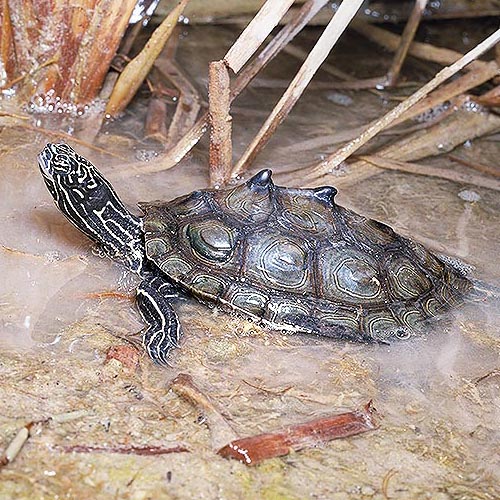
The Graptemys oculifera is endemic to USA © Giuseppe Mazza
Similarly to the species of terrestrial tortoises, the sexual dimorphism is displayed by the tail, of bigger size at the base and longer in the males than in the females and by differences in the shape and colouration of the carapace and in the dimensions (bigger in the males), of the nails.
The females lay in a hole, filled up of vegetal wastes and fragments, from 5 to 17 eggs with an elongated morphology with a shell which is more robust than that of other families.
The young have initially a more harmonic and round shell, with brighter colourations, which, during the development and the growth, will become more angular.
Two much known species are the Trachemys scripta (subfamily Deirochelyinae) and the Emy orbicularis (subfamily Emydinae).
Examples are the Painted Turtle (Chrysemis picta) which lives in North America, from Canada to southern USA. It has a greenish shell and red stripes on the head. These nice turtles are often bred as domestic animals. But, being unluckily freed warily, they have invaded Europe as alien species.
Aggressive and with a high rate of fertility, they are creating serious problems to the autochthonous turtles, with which they are competing due to the overlapped alimentary ecology. They have a frugivorous, vegetarian regimen, but they can also nourish of terrestrial molluscs.
European Pond Terrapin (Emys orbicularis), lives mainly in southern Rurope, but can move northwards, reaching northern Germany. It has a vegetarian, insectivorous and frugivorous regimen.
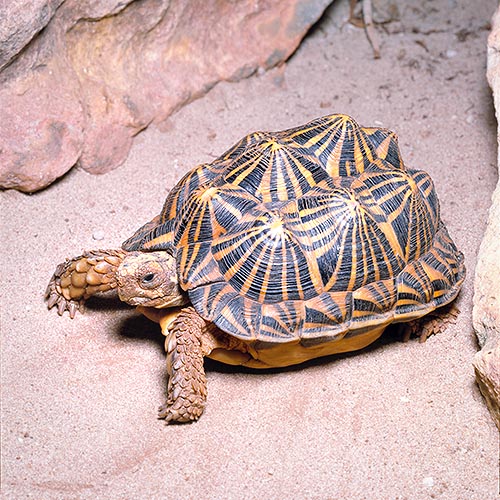
The Psammobates tentorius is a splendid tortoise of South Africa © Giuseppe Mazza
The species Pseudemys floridana, freshwater turtle common in southern USA and in Mexico, nourishes of vegetal debris, humus which is eaten getting out from the water and of dead leaves. They are apathetic animals, lazy, which stay warming in the sun on floating logs. The biologists think that the solar heat helps their digestion and frees them from the pests.
♦ Testudinae : the terrestrial and aquatic tortoises, with 115 species. This family includes the most common terrestrial and freshwater tortoises. The terrestrial ones are spread in all warm regions of the world, but Australia, and in all terrestrial habitats and biotopes, from the deserts to the tropical forests and the oceanic islands. Usually, they have stocky legs with claws; the shield is convex.
The Leopard Tortoise (Geochelone pardalis) lives in southern and eastern Africa. It can reach the 58 cm of length.
It has a frugivorous, herbivorous alimentary regimen, but it can nourish also of insects and terrestrial molluscs, such as the gastropods.
A typical insular species, colonizing descendant, is the Giant Tortoise (Dipsochelys elephantina), from Aldabra, pristine coral atoll emerging from the Indian Ocean, almost untouched by man, called also Seychelles Giant Tortoise. It maybe comes from an extinct species which had come by sea from India. It has enormous dimensions.
♦ Geoemydidae, known also as Bataguridae, are tortoises utilized as ornament, called also the Ornate Wood Turtle and are endemic to Central America, where they are free in all pluvial forests of Nicaragua, Mexico, Guatemala, Panama and Costa Rica.
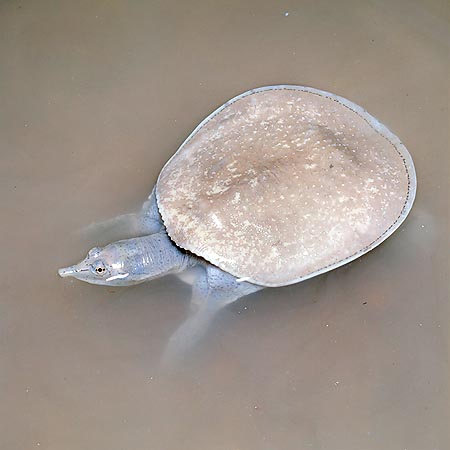
The Trionyx spiniferus of North America has no bony scales © Giuseppe Mazza
They are utilized (as they are not included into the red list of threatened endangered species of the IUCN), for the trade, as animals of ornament.
The colour of the carapace has an ample range of chromatic combinations.
Usually, however, those of southern Nicaragua have less bright colour than the Costa Rican ones, which are between those with the brightest colours.
Some of the most characteristic specimens of these areas have black ocelli around the eyes, with yellow-orange sprays in various gradations, and the plastron can be sprayed of red or pink. The adults can reach the 20 cm of length.
A particular species, the Black Wood Turtle (Rhinoclemmys funerea) has the biggest specimens of the family and ca reach the 35-38 cm of length.
Other much commercialized species are the Brown Wood Turtle (Rhinoclemmys annulata), the Rhinoclemmys areolata, known as Furrowed Wood Turtle, the Rhinoclemmys diademata, called Diadem Wood Turtle, and the races or subspecies Rhinoclemmys punctularia punctularia and Rhinoclemmys punctularia flammifera.
They are semi-terrestrial because they love to live in very wet zones, with close to them at least one pond, even if muddy, where often they bathe during the day. They are omnivorous, as they nourish of berries, grass, fruits as well as of insects, arthropods and are particularly greedy of orthopterans (crickets, grasshoppers, locusts), but also of small mammals, like dormice and small lizards. They eat quite willingly also earthworms and snails.
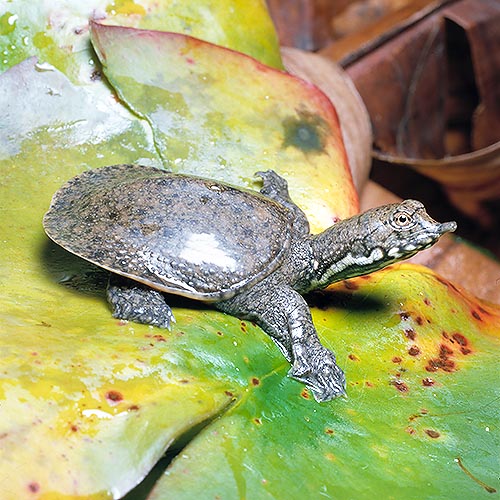
The Trionyx sinensis tuberculatus is frequent in central China and Taiwan © Mazza
Superfamily Trionychoidea
♦ Carettochelydae: it counts one species only, the Carettochelyd (Carettochelys insculpata).
This very rare tortoise lives in the rivers of New Guinea. It has a completely bony shell, not covered by horny scales, even 40 cm long.
It nourishes mainly of insects, larvae, arthropods and freshwater molluscs, but can attack also freshwater fish.
♦ Trionychidae: this family counts 22 species, conspicuously aquatic, which live in freshwaters of North America and Asia and do not have bony scales.
A known member is the Trionyx (Trionyx spiniferus), which lives in the eastern zone of North America. It nourishes of aquatic insects and of crayfish; it reaches the 40 cm of length.
The Trionyx ferox , from Florida, has an elongated snout with which it can breathe even if completely submerged in the water. Ferocious, aggressive and with a shell of coriaceous skin, without horny protection, it is however preyed by alligators and caimans.
Superfamily Kinosternoidea
♦ Dermatemydae: it has one species only, the Dermatemyd (Dermatemys mawii).
Little is known about the biology of this turtle, long even 30 cm, which lives in the rivers of the coast of Mexico and of Guatemala.
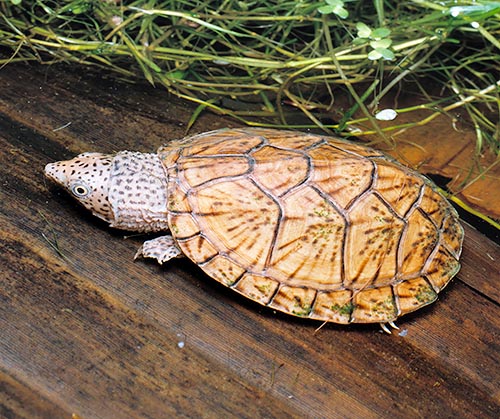
The Sternotherus minor emits a typical musky smell © Giuseppe Mazza
♦ Kinosternidae: about 25 species. They are the smallest tortoises.
They can reach a maximum of 26 cm of length; some are only 14 cm long.
The males have a tail which is longer than that of the females and broad at the base, even if their body is smaller than that of the females, all marks of sexual dimorphism.
They are also called “musk turtles”, as the males emit a smell similar to that of the musk from their perianal glands. It is a sex pheromone.
Others, due to their style of life, are called “mud turtles”. The carapace can be yellowish, black, brown or olive-green.
Although most of the 25 species do not have marks on the shell, some of them have some black striae. Many species do have, on the contrary, yellow striae on the sides of the head.
They are endemic to North and South America, especially to swampy and wet areas.
They are purely carnivorous as they nourish of crustaceans, molluscs, annelids, fish, insects, reptilians, amphibians and of carcasses. It would seem, in particular for the species (Kinosternon angustipons), that some of these tortoises show a sort of form of parental care.
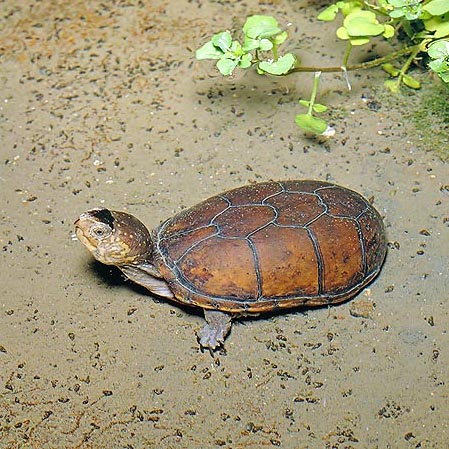
The Kinosternon subrubrum has an articulated plastron © Giuseppe Mazza
The American biologist Legler, in 1965 in Nebraska, has observed that the female of Kinosternon angustipons, after having laid four-five eggs in a hole dug in the mud, during late spring, early summer, remained close to them, leaving them only for getting nourishment.
And before doing this, urinated often on them, in order to modify their smell to the predators, especially various species of snakes.
Other species are the Kinosternon scorpioides, Kinosternon subrubrum, called always mud turtles and the Sternotherus carinatus and the Sternotherus depressus, called musk turtles.
Superfamily Chelonioidea
♦ Chelonidae : these are the marine turtles, with 5 species; the members of this family beach only for the reproduction. The coupling may take place at sea or on the beach, depending on the species. In comparison with the terrestrial tortoises, the robust forelimbs are formed as a fin and the body is tapered in an antero-posterior direction. The head cannot retract into the shell.
Examples are the Green Sea Turtle (Chelonia mydas), living in all warm seas. In Malaysia, its reproduction areas are protected in natural marine parks. It can weigh up to 450 kg and can reach the 120 cm.
It is the only one reptilian capable to perform long migrations. During the seventies, an experiment on the field was performed. Some biologists labelled several specimens of Chelonia mydas on the Ascension Island, and the same were found 3.500 km far away, along the Brazilian coasts.
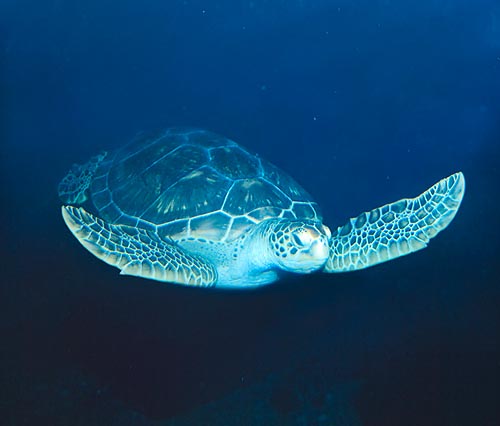
The Chelonia mydas lives in all warm seas and does long migrations © Giuseppe Mazza
The other marine turtles effect even hundreds of kilometres long trips, but shorter than these migrations. It nourishes of cephalopods, echinoderms (starfish), gastropods, sea urchins and some types of fish.
The Caretta caretta lives in temperate waters, like in the Mediterranean Sea, and is in serious danger of extinction.
The IUCN and the CITES are constantly controlling its population, by means of a computer network (Tartanet) through which the biologists of the countries facing the Mediterranean record the various sightings.
The warm sea of Greece is a wonderful habitat for the Caretta caretta which move to lay their eggs on the beach of Lagana in the island of Zante, or in the bay of Mounta in Kefalonia.
The species, as already briefly said, is strongly threatened in the entire Mediterranean basin and is by now very close to the limit of the extinction in the Italian territorial waters.
By its birth, the Caretta caretta is about 5 cm long. The length of an adult specimen is of 80-140 cm, with a weight which can vary from 100 and 160 kg.
The head is big, with a much curved beak. The limbs are much developed, especially the fore ones and equipped with two nails in the young individuals, which then reduce to one in the adults. It has a brick-red coloured carapace, with dark striae in the young specimens, and a heart-shaped yellowish plastron, often with wide orange dots.
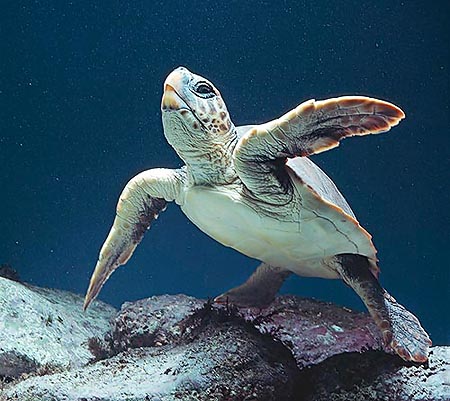
The Mediterranean Caretta caretta is in serious extinction danger © Mazza
Also this species avails of the homing during the heat period for going back to the place of birth, where the females will lay their eggs.
The copulation and the deposition happen on the beach.
The depose up to 100-200 white eggs, with a soft shell, as big as table-tennis small balls, placing them in holes deep even 50 cm, which are dug with the fore limbs.
Then, they cover them carefully, in order to guarantee an incubation temperature constant and for hiding their presence to the predators.
Once the operation is completed, they go back to the sea. A rite which can be repeated several times during the same season, at intervals of 10-20 days.
The eggs have a time of incubation of about 6-7 weeks and, thanks to mechanisms not yet clear to the biologists, open all at the same time.
If the incubation temperature is more than 28°C, from the eggs will come out females, if the temperature is lower, we shall get males.
The young, for getting out from the egg, utilize a particular structure, present also in the birds: the “egg tooth”, which will be, later on, reabsorbed in a couple of weeks. Once out from the shell, they take from two to seven days for digging the layer of sand which covers the nest and for surfacing.
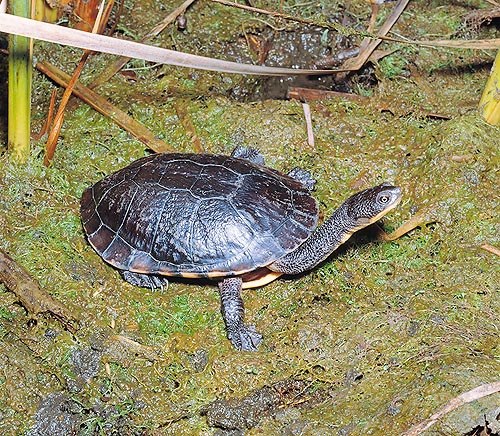
The snake-neck tortoise (Chelodina longicollis) lives in Australia © Giuseppe Mazza
Then, usually by the nightfall, they make for the sea, probably led by the smell of the water and by the reflex of the moonlight and by the stars on the marine surface.
Only a small percentage of the enormous number of young of turtle, which clumsily move towards the open sea in the darkness, will survive, as several predators are lurking. Seabirds (pelicans, albatrosses, shearwaters), but also mammals, such as foxes, wildcats and reptilians (snakes, saurians) which, knowing when the event takes place, stay around in ambush.
Unluckily, also the human being belongs to these predators, with the difference that he does not do this for alimentary purposes, but for a merely commercial intendment.
When at sea, the young turtles swim incessantly for more than 24 hours for getting far from the coast and reaching the continental shelf, where the currents concentrate a great quantity of nourishing substances.
Where exactly they do spend their first years of life is a mystery that the biologists have not yet been able to disclose. Only after some years of life, once reached the dimensions sheltering them from the predators, they will go back to the coastal zones.
When in water, they can reach speeds of more than 35 km/h, swimming easily with the characteristic synchronous movement of the forelegs. They mainly nourish of jellyfish and salps in the deep waters, whilst in the less deep ones, of crabs, urchins and molluscs.
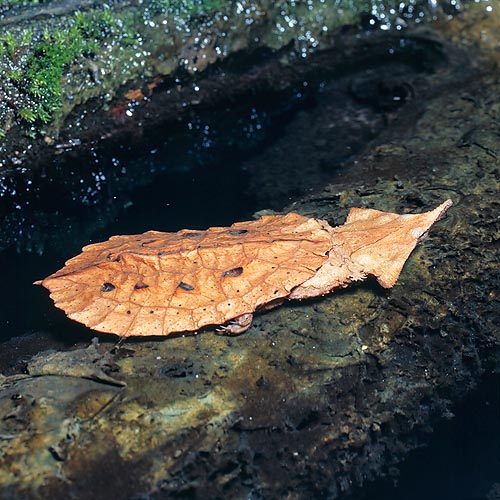
Resembling to a leaf, the Chelus fimbriatus of Amazonas is much camouflaged © Mazza
After having breathed atmospheric O2, through their lungs, they can remain in apnoea even for 30 minutes down to 300 m of depth. They are animals which prefer the bentonic life, surfacing only for breathing.
♦ Dermochelydae: they count one species only, the Leatherback Turtle (Dermochelys coriacea).
This turtle weighs up to 500 kg, reaching the 2 metres of length, and, unlike all other marine species, has a coriaceous skin. It lives in the warm seas, where it nourishes of jellyfish and tunicates, but is now very rare.
Like the other marine turtles, it reproduces laying the eggs in dens dug in the sand, in the same beaches where the mothers were born. A phenomenon which, because of its mysterious perfection, was almost defined as supernatural by the biologists who observed it by the beginning of the nineteenth century. Nowadays, experimental data on hand, they are identifying the nautical modalities which allow the marine turtles (males and females) to retrace, at thousands of kilometres of distance, the place of their birth and to return there. Probably, they base themselves on a whole of mechanisms exploiting the geomagnetic field, perceived by means of magnetite crystals located in their brain, on the capacity of recognizing the astronomic disposition of the stars in the firmament, and on the capacity to distinguish the course and the direction of the sea currents of warm and cold water and of the waves. This general process of navigation and of flight for the birds, is called homing (self-guided, homebound).
The cuirass of the Dermochelys coriacea looks smooth, because, unlike that of the other turtles, it is a mosaic of small bony plates hidden in the skin. The other turtles have, on the contrary, some horny shields deriving from the epidermidic stratum. A substance commonly known as “turtle”, which has been the origin, in the past, of a pitiless hunting.
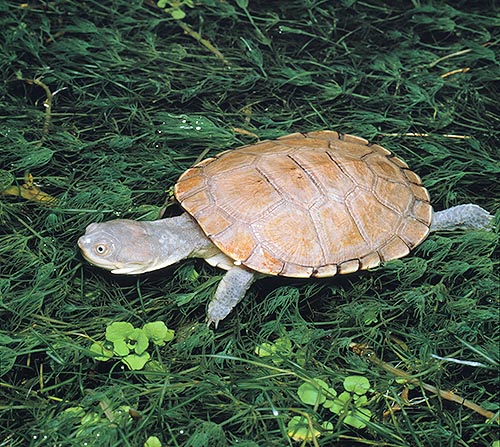
The Pelomedusa subrufa is located in central-southern Africa © Giuseppe Mazza
►Suborder Pleurodira.
The pleurodirs, the tortoises which retract the head into the carapace by bending their neck on the side, are subdivided into 2 families:
♦ Chelidae: 31 species located in South America, Australia and New Guinea. A typical example can be the Chelodina longicollis, measuring up to 30 cm of length, living in the rivers of Eastern Australia and nourishing of fish.
The Mata mata (Chelus fimbriatus) of South America, has an elongated snout and has, around the jaws, some fleshy growths which attract the preys (fish, amphibians), simulating in turn to be their own prey.
The structure of the plastron, having the shape of a leaf, with a gold-yellow colouration, typical of an old leaf fallen in the water (phenomenon of Batesian mimicry), associated to the capacity the have to stay motionless, allows the preys to get closer without realizing the danger. When the prey is at the right distance, the animal opens suddenly its mouth, sucks and swallows it.
Superfamily Pelomedusoidea
♦ Pelomedusidae: 14 species of South America, Africa and Madagascar. The neck is hidden by the skin when the head is retracted. An example is the Podocnemis unifilis, which lives in the rivers of South America nourishing of fish, molluscs and freshwater crustaceans and which reaches the 70 cm of length.
♦ Pedocnemididae: Spread in Madagascar and in the northern part of South America. They have the typical characteristic of the suborder of the Pleurodira, that is of not retracting the head into the carapace, but to bend the neck on a side in such a way that the head is protected by the carapace.
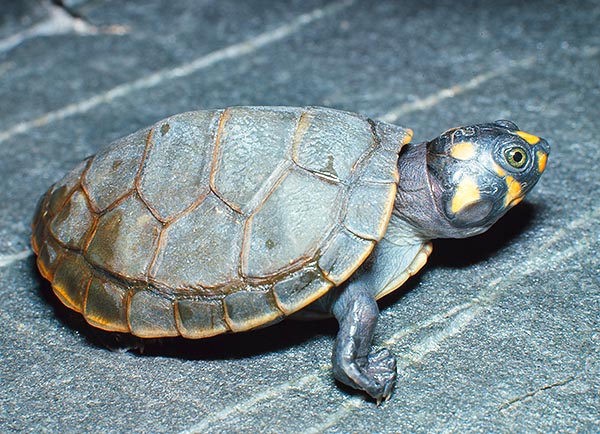
In the Podocnemis unifilis the neck is hidden by the skin, with retracted head © Giuseppe Mazza
They live (particularly those of the northern part of South America) along the water streams, rivers, streams, but can also live close to the big lakes or ponds and also in the typical South American swamps.
They usually live in water, but can move, for instance the South American ones, inside the pluvial forests. In Madagascar, they live in the coastal forests and can be found also along the coasts of Eastern Africa.
These reptilians are preferably vegetarian and frugivorous. As a matter of fact, they nourish of aquatic plants, grass, fruits falling on the ground or in the water from the trees, and quite willingly eat also succulent plants.
They can also eat aquatic larvae of insects, as wall as insects themselves and small fish and crustaceans.
The behaviour is related to the habitat where they do live. Some prefer to stay always in the water of lotic aquatic water bodies (rivers, streams), others on the edges, some in pools of stagnant waters, but in any case, the females, when close to the time of the eggs deposition, will dig a hole on the edge where they will lay them.
The carapace can reach even 1 m of length, therefore they are very big; usually, it is of brown colouration, at times green-black maculated. Most unluckily, the flesh and the eggs of these tortoises are very much sought for on the market, therefore these animals are often subject to be hunted. One of the most known species is the Podocnemis expansa, with a carapace long up to 80 cm; others are the Podocnemis unifilis and the Podocnemis vogli.
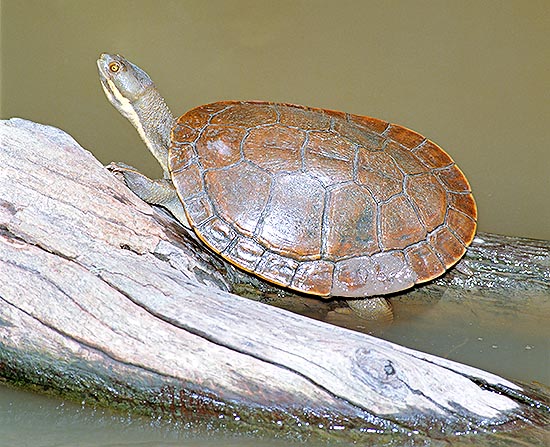
The Emydura macquarii is a rare Australian Chelidae endemic to the Bellinger River © G. Mazza
Fossilized remains of skeleton and carapace, found by the biologists in the northern forests of South America during the sixties, have revealed the existence, during the Quaternary (period Early Pliocene, about 3 millions of years ago), of a progenitor of the members of this family, called Stupendemys (genus Stupendemys), with a carapace long up to 2 m and which lived in Venezuela and in Brazil.
On the islands forming the Galapagos Archipelago, the English biologist Charles Darwin met, during his voyage as ship’s scientific officer onboard the brig Beagle, the great terrestrial tortoise (Geochelone elephantopus), which can have the carapace 2 m long per 500 kg of weight. Its population was almost extinct during the sixties because they had imported several heads of goats which had, while gazing, almost completely eliminated the vegetal forms they eat.
Nowadays, the biologists are managing, thanks to programmes of Taxon Advisory Group and of Biology of Conservation, to repopulate the species. They can live and reproduce even for 90-100 years.
In this respect, we must not forget that the herpetologist biologists, depending on the Galapagos island where they were, have remarked that such tortoises have a different shape of carapace. They have been identified as races or subspecies of the species Geochelone elephantopus. The differences between their dorsal shells show that populations even common origin tend to differ because of geographic isolation (Allopatric Speciation).
The specimens with saddle-shaped shell live in some islands of the archipelago, those with dome-shaped one on others; the biologists hypothesize, however, that all are coming from a sole ancestor, the Geochelone elephantopus.
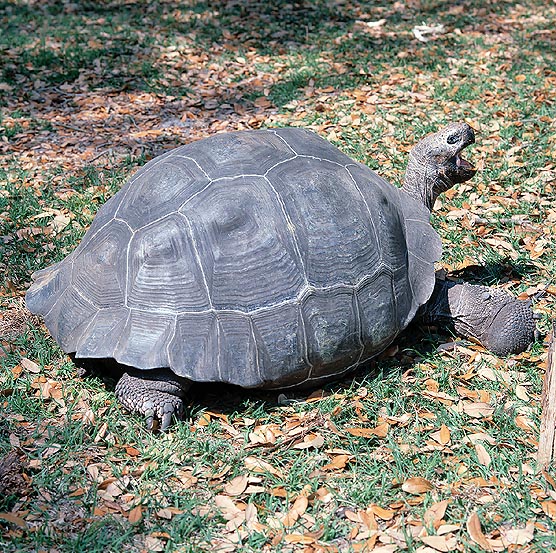
The Geochelone elephantopus is smaller than the Seychelles giant turtle © Mazza
Subspecies:
Geochelone elephantopus abingodoni : Pinta Island.
Geochelone elephantopus phantastica : Isabel Island.
Geochelone elephantopus elephantopus : Fernandina Island.
Geochelone elephantopus ephippium : Pinzon Island.
Geochelone elephantopus galapagoensis : Floreana Island.
Geochelone elephantopus nigita : Chaves Island.
Geochelone elephantopus hoodensis : Espanola Island.
Geochelone elephantopus chathamensis : San Cristobal Island.
Geochelone elephantopus wallacei : Rabida Island.
Geochelone elephantopus darwini : Santiago Island.
